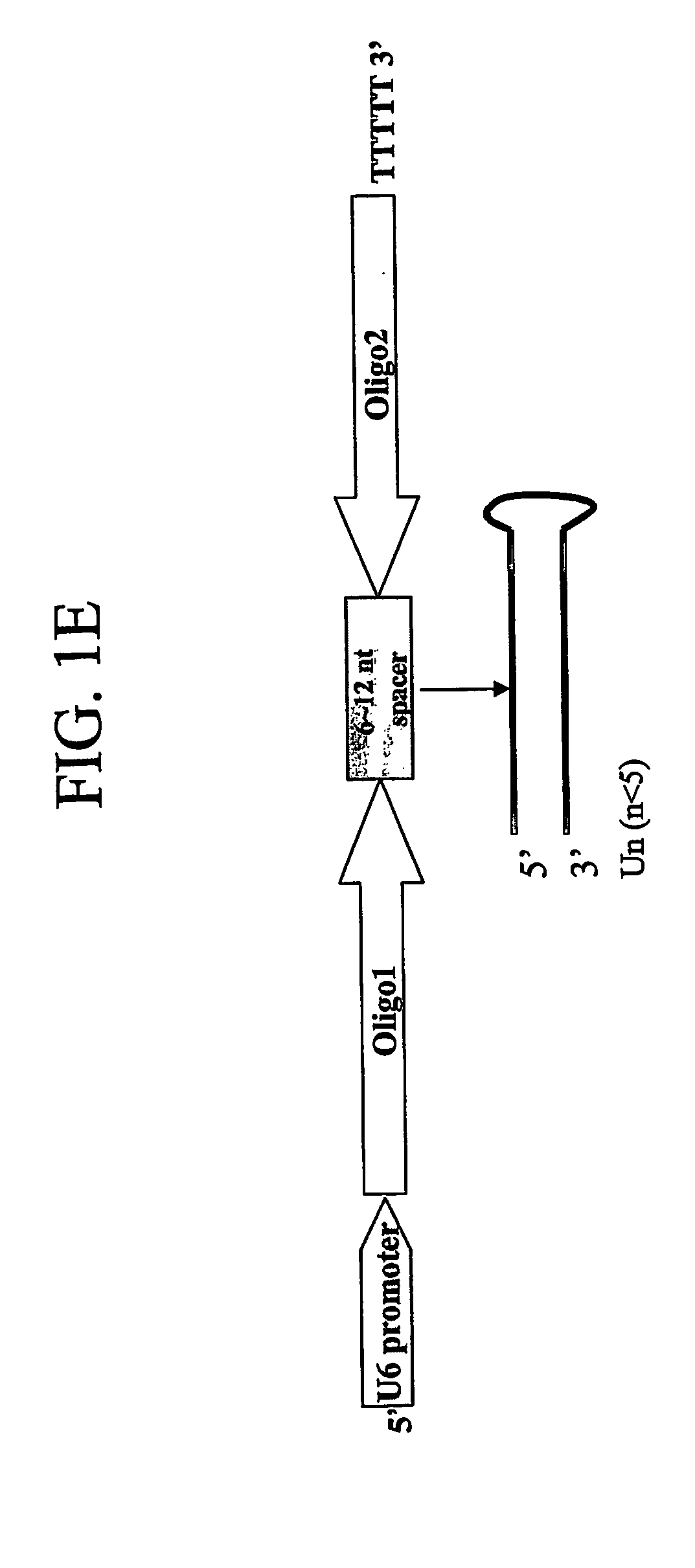Vectors for regulating gene expression
a gene expression and gene technology, applied in the field of vectors for regulating gene expression, can solve the problems of viral-mediated gene transfer application, acute inflammation and immune response, and major obstacles to acute inflammation and immune response, and achieve the effect of reducing the expression of a target gen
- Summary
- Abstract
- Description
- Claims
- Application Information
AI Technical Summary
Benefits of technology
Problems solved by technology
Method used
Image
Examples
example 1
A Vector for Silencing Expression of Gene(s) Using Adeno-Associated Virus as Vector for Gene Delivery
[0081] Plasmid vector pSMWZ-1 was created by the following steps: (i) the pCMV-MCS plasmid (STRATAGENE) was digested with Not I and the larger fragment, containing the ampicillin gene, was ligated to the synthetic adapter, containing, in order, Not I-Kpn I-Apa I-Xho I-Hind III-EcoR I-Bam HI-Sac II-Sac I-Cla I-Sal I-Bgl II-Not I; (ii) the suppressor cassette, containing the mouse U6 promoter linked to a multiple cloning site, was obtained by PCR amplification, using specific primers with the desired restriction sites from the template pSilencer 1.0-U6 (AMBION), and inserted in the adaptor at the appropriate sites; and (iii) the modified pCMV-MCS plasmid was digested with Not I and the smaller fragment was ligated to the 2.9 kb fragment of pAAV-MCS (STRATAGENE) obtained following its Not I digestion. Plasmids pSMWZ-2 and pSMWZ-3 were created by inserting additional suppressor cassette...
example 2
Promoting and / or Suppressing Multiple Gene Expression Using Adeno-Associated Virus as Vector
[0082] To produce dual function AAV vectors that are capable of promoting expression of one or more genes, while simultaneously suppressing expression of one or more other genes, the promoting genes (p-genes) are directionally inserted into EcoR I and Xho I sites in the plasmid pCMV-MCS (STRATEGENE). The recombinant pCMV-MCS plasmid was then digested with Not I and the fragment containing target genes was isolated and ligated to the larger 2.9 kb fragment of pAAV-MCS after its digestion with Not I. Next, the recombinant AAV-MCS was redigested with BstE II and Rsr II, and the product was purified. Secondly, to further clone the suppressor cassettes, the pSilencer 1.0-U6 (AMBION) was digested with Kpn I and Bam HI, and the smaller fragment, harboring the U6 promoter and a few restriction endonuclease sites, were purified and ligated with the linkers BstE II-Kpn I and Bam HI-Rsr II at both ends...
example 3
A Vector for Silencing Expression of Gene(s) Using Non-Viral Gene Delivery
[0083] To produce plasmid vectors capable of producing a gene suppressor, the plasmid pVAX-1 (INVITROGEN) was digested with Mlu I and Xcm I, and the purified fragment was ligated with an adaptor containing, in order: Mlu I-Kpn I-Apa I-Xho I-Hind III-EcoRI-Bam HI-Sac II-Pst I-Cla I-Sal I-Bag II-Not I-Xcm I. The U6 promoter was inserted into the pVAX vector by PCR amplification of the promoter using vector pSilencer 1.0-U6 (AMBION) as a template and specific primers with the appropriate restriction sites. The U6 promoter was inserted into the adaptor at the Kpn I / Apa I, EcoR I / BamH I and Cla I / Sal I sites, respectively, to construct the different vectors with a single or two or three U6 promoter(s). These vectors will allow cloning of the specific suppressor oligos encoding siRNA for the desired gene(s) cloned behind the U6 promoter(s) to silence the corresponding target genes.
PUM
| Property | Measurement | Unit |
|---|---|---|
| nucleic acid | aaaaa | aaaaa |
| pharmaceutical composition | aaaaa | aaaaa |
| stability | aaaaa | aaaaa |
Abstract
Description
Claims
Application Information
 Login to View More
Login to View More - R&D
- Intellectual Property
- Life Sciences
- Materials
- Tech Scout
- Unparalleled Data Quality
- Higher Quality Content
- 60% Fewer Hallucinations
Browse by: Latest US Patents, China's latest patents, Technical Efficacy Thesaurus, Application Domain, Technology Topic, Popular Technical Reports.
© 2025 PatSnap. All rights reserved.Legal|Privacy policy|Modern Slavery Act Transparency Statement|Sitemap|About US| Contact US: help@patsnap.com



